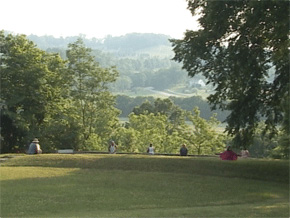SERPENT MOUND
THE MYSTERIES OF THE SERPENT
From the diversity of its modern visitors, it is clear that Serpent Mound means many things to many people,
yet it is little understood by archaeologists today. Questions persist about its date, its builders, and its
meanings. Indian stories also vary widely: some even consider it an evil place! Arc Director Nancy Stranahan
ponders this sense of mystery:
Serpent Mound is truly a powerful sacred site. I actually feel very humble trying to give voice to it, but I
can tell you how it affects me. A serpent is the symbol of mystery, we don’t understand it, we know almost nothing
about it. When we interpret it, we mostly tell what we don’t know. In that, I think, lies its power. We feel we
know so much, and yet we mostly live in an unknown universe, and I think Serpent Mound is that gateway to remembering
that we don’t really know anything. What we know is a particle or grain of sand on a beach.
Even for scholars of the site, its meanings are uncertain: It may be the “Horned Serpent” of Native American legend,
perhaps in the act of swallowing the sun, in an eclipse. Built around 1066, it may be related to the “blazing serpent
in the sky” that we call “Halley’s Comet” – its brightest known appearance was that year.
The iconography resembles Mississippian serpents from the same time period, found on artworks from among the urban
cultures farther west. The Great Serpent, through its fame, has been opened up to many interpretations, for many
people, groups, and traditions. A visit during the sunset celebrations on any June 21 tells the story: Indians
from many tribes and groups, new-age mystics, earthworks enthusiasts, among others, together have many ideas about
what makes this place sacred, somehow spiritually loaded.

Native Americans and many others gather for the annual celebration of the summer solstice sunset.


